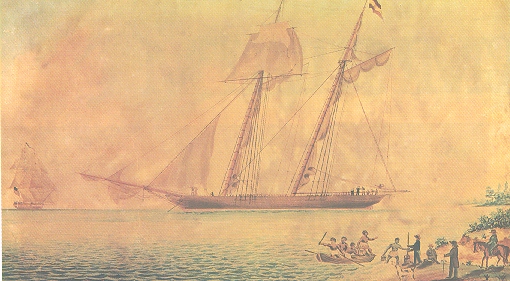| 1837 - 1839 | 25,000 Africans brought to Cuba as slaves. |
| April 1839 | Cinque captured by other Africans, taken to the slave factory in Lomboko and sold to a Portuguese slave trader. |
| April - June 1839 | Cinque and others resold to another slave trader and put aboard the Tecora which sailed to Cuba. |
| June 1839 | Cinque and others sold to Ruiz and Montes in Havana, Cuba. Amistad leaves Havana for Guanaja with slaves and owners. |
| July 1839 | Mutiny led by Cinque; Amistad's captain and cook killed while two crewmen escape; Africans control Amistad. |
| July - August 1839 | Amistad steered by Montes east by day and northwest by night, toward United States. |
| August 1839 | Amistad captured by crew of U.S.S. Washington off of Long Island, New York; Africans held and taken with Amistad to New London, Connecticut; Judicial hearing, presided over by Judge Judson, on the U.S. S. Washington; Africans await trial in a New Haven, Connecticut jail. |
| September 1839 | Lewis Tappan forms Friend of Amistad Africans Committee; Judge Thompson presides in Circuit Court hearing on Amistad criminal case; case dismissed by Judge Thompson for jurisdictional reasons; civil case left for District Court resolution. |
| October 1839 | Professor Josiah Gibbs locates interpreter, James Covey, and the Africans are able to tell their story; teaching Africans the English language and Christianity began; Cinque and others file charges of assault and false imprisonment against Ruiz and Montes. |
| November 1839 | District Court meets and postpones case. |
| December 1839 | Slave factory at Lomboko, Sierra Leone raided by British and all slaves there liberated. |
| January 8, 1840 | The Amistad civil trial begins in New Haven. |
| January 15, 1840 | Judge Hudson presiding in District Court rules the Africans are to be turned over to the President for return to Africa. |
| August 1840 | Africans taken to Westville. |
| September 1840 | Judge Thompson of the Circuit Court upholds District Court decision; government appeals to U.S. Supreme Court. |
| October 1840 | John Quincy Adams convinces to join Roger Baldwin in arguing the case for the Africans before the Supreme Court. |
| Feb. - March 1841 | Baldwin and Adams argue case before Supreme Court; Court orders Africans to be freed immediately. |
| Mar. - Nov. 1841 | Freed Africans go to Farmington for further English and religious education; local committee plans mission establishment in Africa. |
| November 1841 | African survivors leave with missionaries for Africa aboard Gentleman. |
| January 1842 | Arrive in Sierra Leone; mission experiences problems; many of the Africans abandon missionaries. |
| 1846 | Brother Raymond, founder of the mission in Sierra Leone dies of yellow fever and is replaced by George Thomas; 68 students attend the mission; efforts to compensate Spain for the Amistad are opposed in the House by John Quincy Adams. |
| 1860 |
With the election of Abraham Lincoln as President, efforts to compensate Spain for the Amistad incident come to an end. |
| 1879 | Cinque, old and emaciated, comes to the mission to die and is buried among the graves of American missionaries. |
The Amistad Case: A Chronology
- Details

